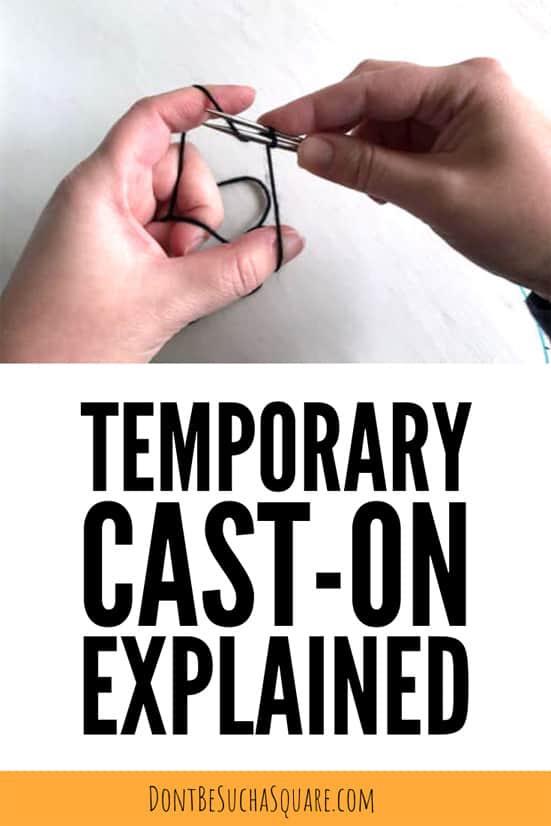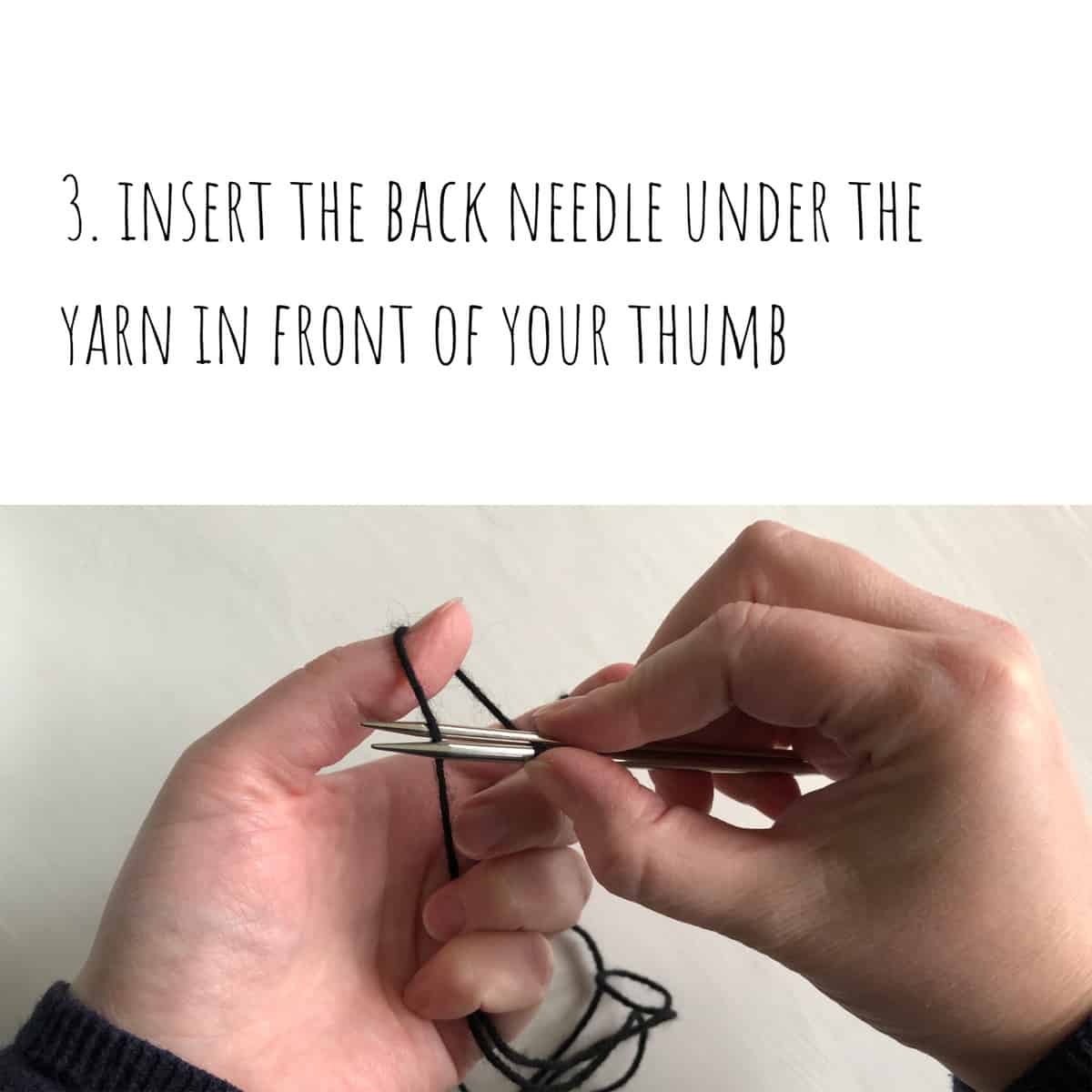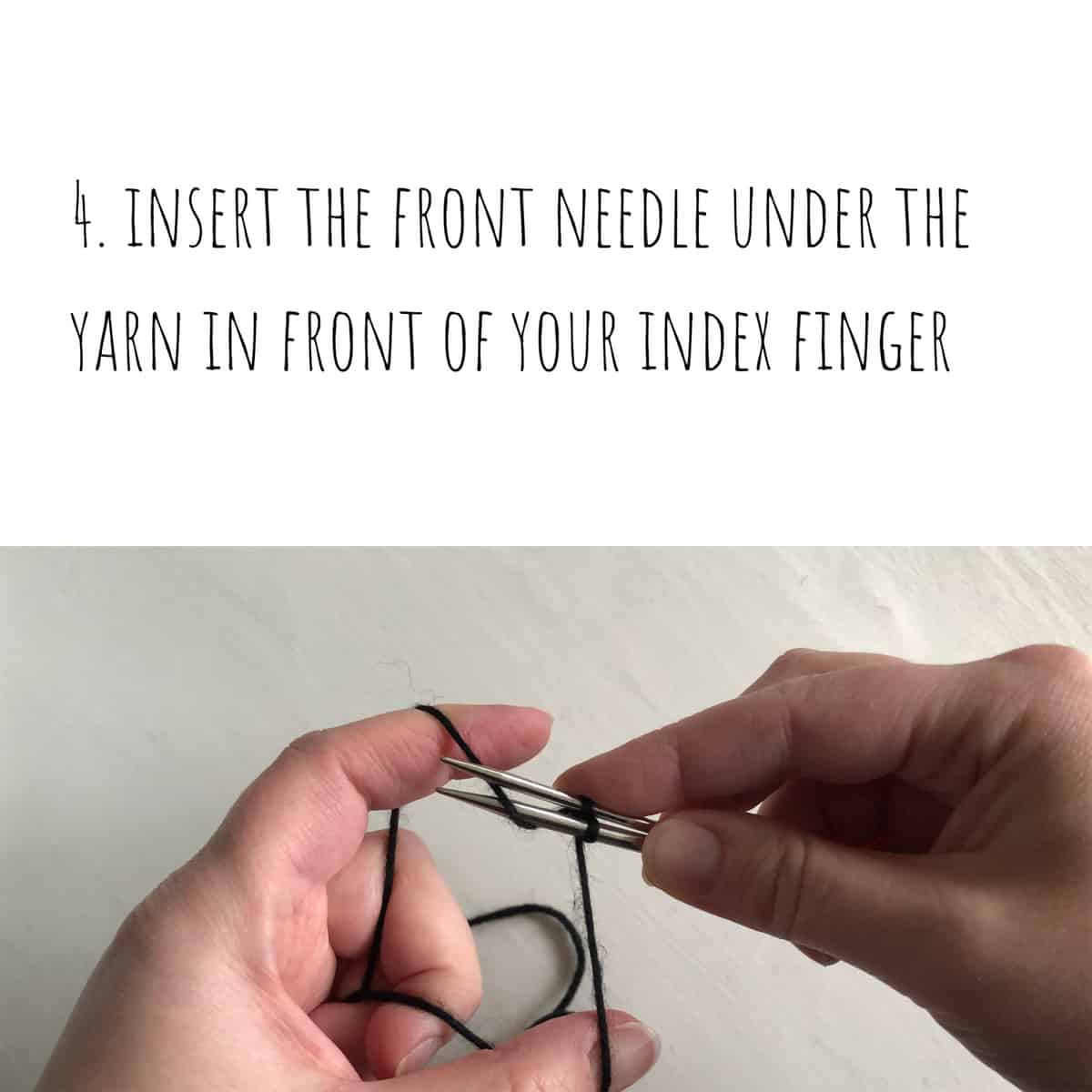What is a provisional cast-on?
A provisional cast-on is a temporary cast-on that can be removed. This means that the cast on edge isn’t really an edge, but a live set of stitches that can be picked up and worked later.
What’s the purpose of a temporary cast-on?
This type of cast-on is used when you need to be able to pick up your stitches from the cast on and continue knitting in the opposite direction or grafting pieces together.
When to use a provisional cast-on
- If you want to add the edging last, like for example:
- add a collar on a top-down sweater
- or adding cuffs to a sweater
- you don’t know how long you need your finished project needs to be or if you have enough yarn.
- When you want to add the same edge to the bind-off and cast-on edge. This is useful for:
- blankets
- scarves
- wrist- and leg warmers
- If your project needs to be grafted at the end.
- Sometimes you may want to see how your project turns out before taking any decisions on the edges.

There are different ways to cast on temporary
There are many ways to do a provisional cast-on and I have to admit that I don’t know them all. But, I know some of them and I have listed them in this post so that you can try them out and see if you find one that you like!
Most of these methods use waste yarn, some of them call for a crochet hook and a few make use of both.
The easiest provisional cast-on I have found
This technique for making a provisional cast-on is the easiest I have stumbled upon yet.
You don’t need any waste yarn or a crochet hook and the steps are super easy to follow! In addition to that, there’s no need for picking up stitches! They will be sitting at your spare needle the whole time.
The cast-on is also invisible once you have knitted with all stitches. I guess I don’t have to tell you that this is my favorite provisional cast-on?
Those who are familiar with Judith’s magic cast-on, will recognize this as it’s, in fact, the same method!
But instead of knitting in the round, we will be knitting flat, leaving half of the stitches to rest on a spare needle. Judy’s magic cast-on is another of my favorites, this is my go-to for casting on sock toes!
Instructions:
Materials needed: Yarn, Knitting needles and a spare needle.
A circular needle is preferred but a double-pointed needle + some kind of stoppers to put at the ends will work for narrow projects.
1. Set up for adding stitches
Make a slip knot and place it on the needle you plan to knit with first. Pick up the needle and your spare needle. Hold them parallel with the needle with the slip knot in front.
2. How to hold the yarn
Hold the yarn as you were going to do a long-tail cast-on. With the tail over your thumb and the working yarn over your index finger.

3. Add the first loop
Start by picking yarn from the thumb with the spare needle (the one that doesn’t have a slip knot). Insert the needle under the yarn in front of your thumb, let the yarn slip of your thumb to form a wrap around your needle. The yarn should go from the slip stitch, under the needle, up behind and down between the two needles.

4. Add the second loop
Now you should pick yarn from your index finger using the other needle (the one you added the slip knot to). Move the needle upward, above the yarn in front of your index finger and insert the needle behind the yarn. You should have a wrap on your needle with the yarn coming up in front of the needle and down between the two needles.

Repeat step 3 and 4
Continue to add stitches until you have enough.
Start knitting
Work the stitches on one of your needles in your preferred pattern. When you’re ready to knit in the other direction, you don’t have to do anything but add yarn and get to it. Your stitches are already on a needle!
If you have used a spare needle in the wrong size, just knit your stitches over to another needle.
Need more help? Watch the video!
YouTube video: How to do the easiest Provisional cast-on
I also made a short video just to show you the motions described. It’s really easy to do, but a bit hard to describe in text…
The long-tail provisional cast-on
This method is very much like the usual long-tail cast-on. The difference is that the provisional version uses a strand of waste yarn along with the working yarn.
To make this cast-on you need a long piece of waste yarn, at least three times the length of the cast-on.
Instructions:
Materials: Working yarn, waste yarn, and a pair of knitting needles
In this method, we use the waste yarn instead of the yarn tail that usually goes over your thumb.
- With the right hand:
Hold both the waste and the working yarn in your right hand along with a knitting needle. - With the left hand:
Put your left index finger and thumb between the two strands of yarn, as if you were going to do the long-tail cast-on. The working yarn should be over your index and the waste yarn over your thumb. Hold the yarn strands in your hand. - Cast-on
Cast on with the long-tail cast-on. If you don’t know how to do this I have a video of how to do it in this post!
With this method, the waste yarn is incorporated with the cast-on and there’s no way that the stitches could slip off.
This is what makes it a bit tricky when it comes to picking up the stitches again. You will have to undo the waste yarn and pick up the stitches one by one which can be a bit time-consuming.
Provisional cast-on with waste yarn or a directly onto a cable
For this, you need a piece of waste yarn that’s a bit longer than double the length of the cast-on your planing to do.
Or, you can use a spare circular needle or a cable from an interchangeable needle instead. This way you won’t need to pick up the stitches from the cast-on, they will already be sitting on your cable.
I don’t mind having a cable hanging in my project, as a matter of fact, I often have more than one dangling from my knitting to hold arm-stitches for example. But if you don’t like it, or don’t have enough cables/needles to make it work, just use the waste yarn!
This method is easy and crazy fast to do. But one thing I don’t like about it is that I get uneven tension in my stitches on the first row of my resting stitches.
I think it is because every other stitch gets more yarn when they are cast on. Or, it’s just me doing something wrong.
In which case, I don’t use this as much since I think the cast-on gets a bit uneven and therefore visible.

Instructions:
Materials: Working yarn, waste yarn or a spare circular needle, a pair of knitting needles
- What your right hand should do:
Make a slip knot and place it at your right-hand needle. You should hold the needle, the tail of your working yarn and your waste yarn/spare needle in your right hand. - What your left hand should do:
Put your left index finger and thumb between the two strands of yarn, as if you were going to do the long-tail cast-on. The working yarn should be over your index and the waste yarn/spare needle over your thumb. Hold the yarn strands in your hand. - Forming the stitches:
Now you’re going to pick up stitches of the working yarn, alternating picking underneath and above the waste yarn/spare needle.
Start by placing your needle under the waste yarn/spare needle, wrap it with your working yarn and pull it back. This is your first stitch. Place your needle above the waste yarn/spare needle, wrap your needle. This is your second stitch. Continue like this until you got enough stitches. - Not sure it works?
If you’re uncertain if you’re doing it right, pull the waste yarn/spare needle a bit to see if it’s loose. If the waste yarn can move inside the cast-on, your on track. But, be careful not to pull it out of the stitches!
The stitches won’t unravel if they slide off the waste yarn/cable, but it will be tricky to pick them up later. Therefore it’s a good idea to tie the ends of the waste yarn together (so that they form a loop) to prevent stitches from sliding off.
If you don’t have enough yarn to do this, you can try making bows or adding hair clips at the ends of the scrap yarn.
Crochet provisional cast-on
This method uses a crochet hook to crochet slip stitches around the needle. When the slip stitch is worked around the needle it creates a slip stitch chain along the needle. Every stitch in the chain is attached to the needle with a loop.
The loops are your cast-on stitches that you’re going to knit in on your first row.
The size of the crochet hook won’t have any effect on the size of the cast-on stitches, the tension of your cast-on, that is determined by your needle.
Instructions:
- Make a slip knot:
Make a slip knot with the waste yarn and put it on the crochet hook. - How to hold the tools:
Hold the needle to the left of the hook, with the yarn under the needle. - Make a slip stitch
Move the hook over the needle, grab the yarn with the hook and pull it through the slip knot. Move the yarn back to the starting position. - Repeat:
Repeat these steps until you have enough stitches for your cast-on, then crochet a few slip stitches (that’s not around the needle) to make a short crochet chain that will help you later when you’re unraveling your provisional cast-on.
How to start knitting flat
So, when you have your cast-on set up on your needle, it’s time to work your first row, using the working yarn.
It’s best to choose knit stitches or purl stitches for the first row because if you mix them it will be harder to unravel the crochet chain when you are ready to pick up the stitches.
The second row can be worked in any way you prefer.
Crochet provisional cast-on in the round
We use the same instructions for knitting this cast on in the round as for knitting flat. Please read the instructions above!
When using this method, you should not join in the round until you’re knitting the second row. So please follow the instructions above until you’ve worked the first row, join in the round and follow your pattern.
Reading tip:
––> This post includes a video that shows how to join knitting in the round
––> Learn more about what a crochet hook can do for your knitting: Why a crochet hook is a Knitters’s best friend!
Using provisional cast-on when knitting in the round
Using a provisional cast-on for knitting in the round works the same way as for knitting flat.
The one thing that you need to think about is that you don’t join in the round directly after finishing your cast-on, but after finishing the first row of knitting.
